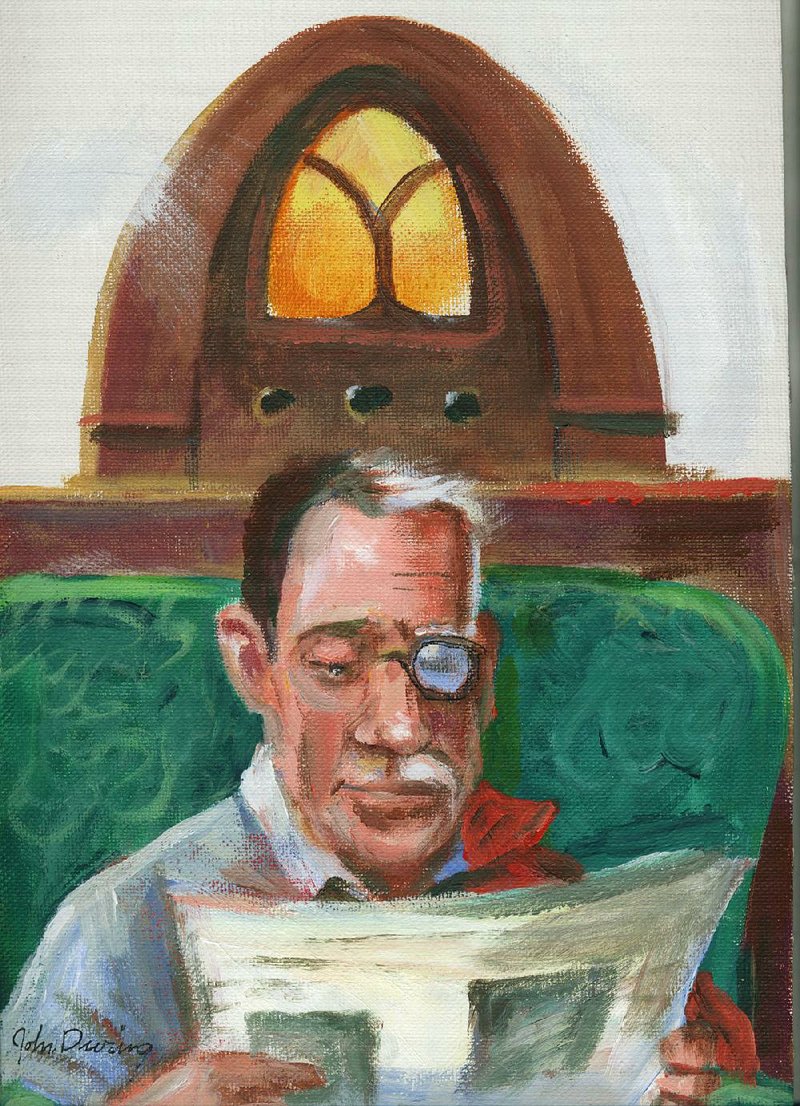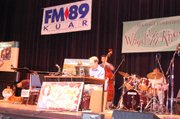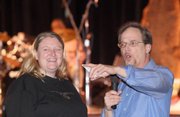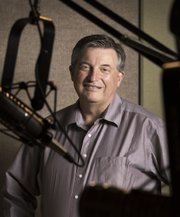National Public Radio came of age in the 1980s, and its audience has matured along with it.
Three decades later, many NPR listeners are reaching retirement age; the network and its 900 local affiliates, including three in Arkansas, face a challenge in attracting younger and middle-aged audiences to replace them.
The Washington Post reports that NPR's research, for example, shows a growing gulf in who's listening to Morning Edition and All Things Considered, daily news programs that have propelled public radio for more than three decades. Morning listening has dropped 11 percent overall since 2010, according to Nielsen research that NPR has made public. Afternoon listening is down 6 percent over the same period.
Listening among Morning Edition's audience has declined 20 percent among people younger than 55 in the past five years and, for All Things Considered, about 25 percent among those in the 45-to-54 segment. The growth market? Listeners over 65, who were increasing in the morning and afternoon hours.
But the so-called "graying" of NPR may not be entirely universal.
"Our numbers are actually fairly good, a little bit better than NPR's in general" among listeners in the 25-34 age brackets, says Nathan Vandiver, interim general manager of University of Arkansas at Little Rock Public Radio stations news-talk-jazz station KUAR-FM, 89.1, and classical music station KLRE-FM, 90.5.
Vandiver, previously the stations' program director, took over the helm following the death in March of longtime General Manager Ben Fry.
Between spring 2012 and spring 2015, Nielsen ratings data shows a decline in average quarter-hour ratings (people who listen for five minutes within a 15-minute period) of 11 percent for total radio listening among young adults age 25-34 and 14 percent in that bracket for total news-talk radio.
Nielsen, however, shows
KUAR doubled total listenership in that age bracket over the three-year sample period -- from an average quarter-hour score (a statistical representation of the number of people listening) of 200 in spring 2012 to a score of 400 in spring 2015.
"It can be a little like comparing apples to oranges when you look at the national numbers and then compare them to your local market, but positive changes in audience numbers are still nice to see," he says. "We're are pulling from a far smaller sample size than the national trend, so our percent changes look bigger.
"There are also more fluctuations from Nielsen survey to Nielsen survey for the Little Rock market than you see when you look at the national numbers, but the fact that we're looking at positive changes in the younger demographics is still a good thing."
FAYETTEVILLE, JONESBORO FIGURES
"I don't think they got it right," says Rick Stockdell, station manager at Fayetteville-based public station KUAF-FM, 91.3, of The Washington Post's assessment. "The average age of listeners has been tracking up over the last several years, but we've been seeing an increase in the 18- to 34-year-olds. We are doing better among that age group than we were 10 to 15 years ago when people who are in their 40s today were that age."
Stockdell says in that same spring 2012-spring 2015 time frame, his average quarter-hour score also doubled in the 25-34 age bracket, from 100 in spring 2012 to 200 in spring 2015.
The biggest chunk of his listenership is still baby boomers -- "the original NPR audience," he notes -- in part because people tend to become more interested in what goes on in the world when it affects them, but "[the number of] millennials seems to have picked up."
Mike Doyle, station manager at Jonesboro's KASU-FM, 91.9, says his audience, too, is skewing slightly younger, although he admits that's relative: His listeners a decade ago on average were in their 60s; now they're in their 50s.
"It hasn't been a steady decline in age, but the last three measurements show that trend," he says.
Radio Research Consortium data from Arbitron, recently bought by Nielsen, estimates the average KASU listener age for fall 2015 at 49.9 years; for spring 2015, 60; for fall 2014, 67. The fall 2011 figures: 33.4 years ("a fluke, we believe," Doyle says). The average age in spring 2009: 68.7 years.
Doyle's spring 2015 figures show the public radio programs showing the strongest performance at drawing listeners younger than 60: Fresh Air, Marketplace, the Saturday morning quiz show Wait, Wait ... Don't Tell Me, Marketplace Weekend, Bluegrass Breakdown, Hand Crank Radio and Women in Music.
Doyle says part of the explanation may be that since the station is based in a primarily rural area, "people are constantly discovering it for the first time."
Some of the locally produced music-based programming, including a program called Arkansas Roots, may be a possible draw for younger listeners; he and his staff are considering several new entertainment shows, some experimental, from public radio content providers, including NPR and American Public Media. And he cites station outreach, including monthly bluegrass concerts in Paragould, coffeehouse singer-songwriter concerts and Arkansas Roots concerts.
"Many of those concertgoers do reflect the aging public radio demographic," he says. "But we've had some people in their younger 40s, their 30s, and even 20-somethings attend those events who become listeners and supporters."
Vandiver credits having some younger voices on the KUAR airwaves, including reporter/anchors Sarah Whites-Koditschek, who does local news fill-ins during Morning Edition, and Jacob Kauffman, who fills the same role during All Things Considered in the afternoons.
Fry's death at 54 has left behind a relatively young staff. Vandiver, at 34, says he is about halfway between the comparative elders (news director Michael Hibblen is in his mid-40s; operations director William Wagner is 51) and the youngsters (Whites-Koditschek, 28; Kauffman, 27; and reporter/anchor Chris Hickey; 27). And, Vandiver admits, it left a large gap in institutional knowledge. (Fry joined the stations in 1988, serving as news and information director and program manager before becoming general manager in 1995.)
Vandiver says there are avenues along which his two stations -- particularly KUAR; with relatively few exceptions, the classical station, at least for the moment, pretty much relies on automated programming -- can take aim at younger viewers through local and NPR programming.
WEEKEND OPPORTUNITY
There's an opportunity this summer to insert something hipper and more contemporary -- "something that speaks to younger audiences," Vandiver says -- into the weekend programming.
Wisconsin Public Radio and show creator Michael Feldman announced in March that production on the long-running public radio talk and quiz show Whad'Ya Know? will end June 30 after 31 years on the air.
"Listener habits and the interests of stations have changed over the 31 years that we've broadcast and distributed the show," Michael Arnold, associate director and director of content at Wisconsin Public Radio, told the online publication Current. In other words, "The listener base has aged as the program has aged," Vandiver adds.
There had been a significant drop-off in the number of public radio stations carrying Whad'Ya Know?, which had peaked in 2003 at 322 stations reaching 1.5 million weekly listeners to 106 stations and a weekly audience of 321,000 as of spring 2015.
A number of stations, including KUAR and KUAF, had stopped airing the two-hour live show on Saturday mornings, substituting the one-hour, prerecorded Whad'ya Know Radio Hour. Vandiver says KUAR is planning to run the full two-hour June 25 farewell show live.
Vandiver says that several currently available quiz and/or interview shows -- Ask Me Another, LiveWire!, The Moth Radio Hour and Bullseye among them -- are under consideration. Or the station might pick up something yet in the works.
Stockdell says his station is airing the quiz show Ask Me Another at 11 a.m.; he expects to move it into the 10 a.m. slot and insert America's Test Kitchen, a recently developed radio version of a popular public TV series. "I think it's a better radio show than a TV show," he says.
EXPANDING PARTNERSHIPS
Meanwhile, Vandiver says, "For local programming, we'll continue to focus our resources around the morning and afternoon newsmagazines" and expanding partnerships with NPR and other NPR stations in Arkansas.
The station is posting "most of our newscasts and longer reports" on NPR One, an on-demand mobile audio app the network debuted last year to stream national and local stories via smartphones and tablets. "It gives us good information about what people like and don't like, and we can use that to improve our content and [formats]," Vandiver says.
The Little Rock stations are also part of a statewide collaboration, a project Fry spearheaded last fall, called Natural State News that also includes KUAF, KASU-FM and Texarkana, Texas, station KTXK-FM, 91.5. (El Dorado station KBSA-FM, 90.9, is part of Louisiana State University at Shreveport-based Red River Radio.)
A $278,300 Corporation for Public Broadcasting grant supports the Little Rock-based statewide news service; its mission is to reach rural areas of the state, focusing on stories about education, health and energy.
Vandiver says the UALR stations are also expanding off-air outreach efforts, including "increasing events like our Pub Quiz," a station-sponsored trivia contest that debuted in August at River Market pizzeria and brewpub Damgoode Pies. A second one is on the blocks for late May.
BOOMERS GO BOOM
The Post reports median age of public radio listeners has roughly tracked the median age of baby boomers. The median NPR listener was 45 in 1995; now he is 54, according to Tom Thomas, co-chief executive of the Station Resource Group, a public-radio strategy and research consortium. "The [aging] trend has been gentle and continuous for the last 20 years," he said.
The network, however, has been exerting itself to attract younger listeners on air and online. For example, last fall, NPR premiered a series on the lives of 15-year-old girls around the world that played on all of NPR's news shows and on NPR.org. NPR also has attempted to foster a community of younger listeners through "Generation Listen," a website that features audio and text stories and news of community events hosted by young NPR listeners.
NPR has added new, younger hosts -- Ari Shapiro, 37, and Kelly McEvers, joining 68-year-old Robert Siegel -- to All Things Considered. They're bumping up against other much more senior brand-name NPR luminaries: morning talk-show host Diane Rehm is 79 and leaving the air later this year; senior national correspondent Linda Wertheimer is 72. Legal affairs correspondent Nina Totenberg is 71.
NEWER TECHNOLOGIES
Meanwhile, audiences have been drifting away from traditional broadcasts to newer on-demand audio sources such as podcasts and streaming. Although radio is still, by far, the dominant way to listen to NPR, the distribution chain now includes podcasts, Web text and streams, satellite broadcasting, social media and apps like NPR One.
"Younger listeners are accessing audio in different ways," Vandiver says. "That means we need to be distributing our local audio online as much, and as well, as we are broadcasting it," such as the Week in Review podcast with which KUAR's news department has been experimenting.
"We'll continue to gather information and look for opportunities there," he adds.
Style on 05/01/2016



